Orchid Cactus (Epiphyllum Cactus): Care and Growing Guide
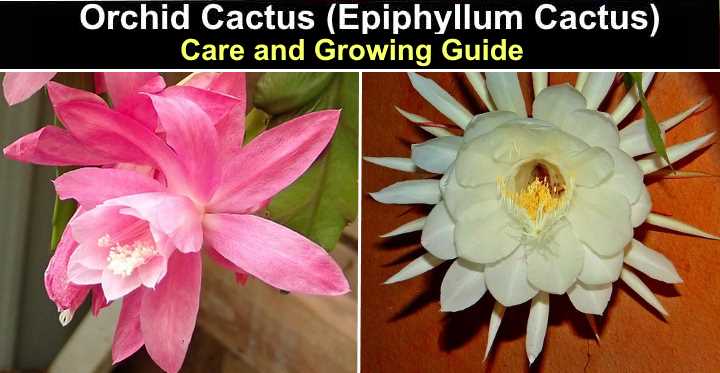
The orchid cactus is a beautiful succulent plant with broad, flattened leaf-like stems and huge, showy flowers. Orchid cactus flowers are the reason most people keep these flowering cacti as houseplants. The large cup-shaped or funnel-shaped flowers bloom in shades of white, orange, yellow, pink, and red. An unusual feature of some orchid cactus plants is that they only bloom once a year during the night.
The most famous orchid cactus is the queen of the night cactus. This night-blooming cactus only blooms during one night of the year. Many other white Epiphyllum cactus are also nocturnal cacti. However, there are types of orchid cacti that bloom during the day, and the flowers stay on the trailing stems for a few weeks.
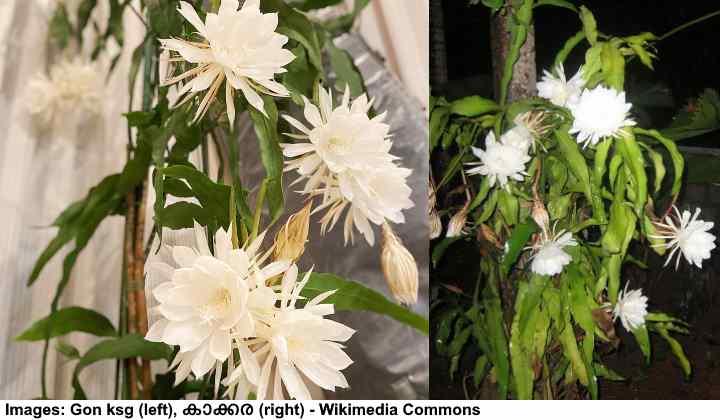
Queen of the night cactus (Epiphyllum oxypetalum)
Getting an orchid cactus to bloom is all about providing the proper care. Blooming orchid cacti require the right amount of sunlight, a cool period during winter, moist soil, and low-nitrogen fertilizer. If you get orchid cactus care right, you can enjoy sweetly scented blooms every year during June and July.
This article is a care guide to growing an orchid cactus. You will learn about getting conditions right indoors to encourage frequent blooming. In addition, helpful tips will help you grow an orchid cactus outdoors if you live in a subtropical or tropical climate.
Orchid Cactus Care
To care for an orchid cactus, grow the Epiphyllum plant in moist, well-drained soil and bright indirect sunlight. Water the forest cactus when the top 1” (2.5 cm) of soil is dry. Use a low-nitrogen fertilizer in February to encourage blooming. Keep humidity above average and temperatures between 65°F and 75°F (18°C – 24°C).
Related reading: Cactus care guide.
What is Orchid Cactus (Epiphyllum Cactus)?
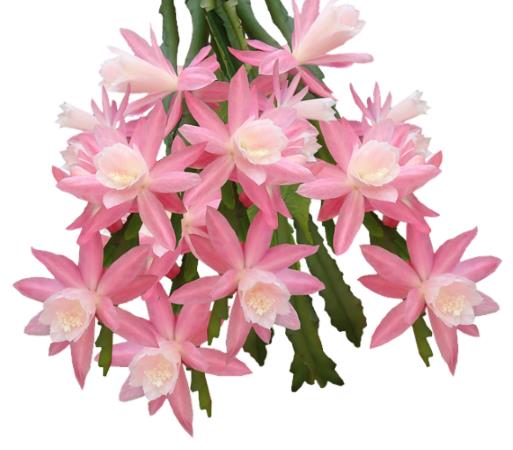
Orchid cactus
Orchid cactus plants belong to the flowering succulent genus Epiphyllum and cactus family Cactaceae. Orchid cacti are identified by broad leaf-like stems with scalloped margins. Large, showy bowl-shaped white flowers are characteristic of many Epiphyllum cacti. Orchid cactus hybrids produce beautiful flowers in colorful pastel shades.
Orchid cacti are native to tropical forests of Central and South America. In their forest habitat, the orchid-like cactus grows as an epiphytic plant in dappled sunlight. The orchid cactus attaches itself to a host plant and absorbs nutrients from its surroundings—like how orchids grow.
Epiphyllum cactus grows outdoors in USDA zones 10 to 12.
Alternative names for the Epiphyllum cactus include Dutchman’s pipe, lady of the night, and climbing cacti.
Although Epiphyllum cacti generally bloom at nighttime, orchid cactus hybrids from the genus Disocactus bloom during the daytime. Many orchid cactus hybrids also have showy funnel or cup-shaped flowers in pink, yellow, orange, and creamy-white hues.
Orchid Cactus Flower
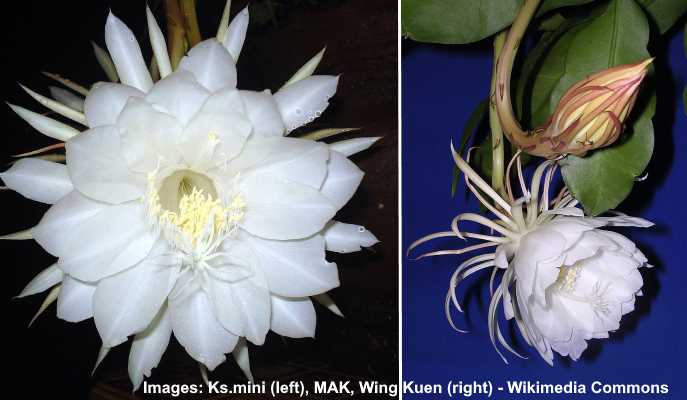
Queen of the night flower
Orchid cactus flowers are huge, sweet-smelling, showy blooms that create stunning floral displays. Epiphyllum cactus flowers consist of around 20 petals that form a cup shape. At the base of the flower, linear or ovate-shaped petals fan out in a circle to form a star-shaped disc. Orchid cactus flowers measure between 3” and 6” (8 – 16 cm) across.
Orchid cactus flower shapes, colors, scent, and blooming time depend on the species.
Many day-blooming orchid cactus plants don’t give off much of a scent. However, some hybrid varieties have large, showy cup-shaped flowers that can be deep red, vibrant pink, orange, or white. Some smaller species of hybrid orchid cacti have narrow, funnel-like flowers like a Christmas cactus.
Nocturnal orchid cacti have some of the showiest white flowers of any cactus species. The rare, spectacular flowers can grow up to 12” (30 cm) long and 8” (20 cm) wide. The snow-white, bowl-shaped flowers also produce a sweet scent that can fill a room.
Types of Orchid Cacti
Here are a few types of Epiphyllum cactus and orchid cactus hybrids:
Queen of the night (Epiphyllum oxypetalum)—This orchid cactus is characterized by long, flattened leaf-like stems, large white showy flowers, and purplish-red fleshy edible fruits.
‘Curly Locks’ orchid cactus (Epiphyllum guatemalense)—An unusual flowering cactus with twisting and curling scalloped stems, white flowers that bloom at night and pink fruit.
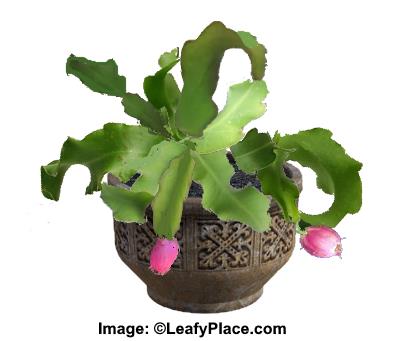
Epiphyllum guatemalense
Epiphyllum ‘Miss America’—The orchid cactus has deep red funnel-shaped flowers and petals in the shape of a star.
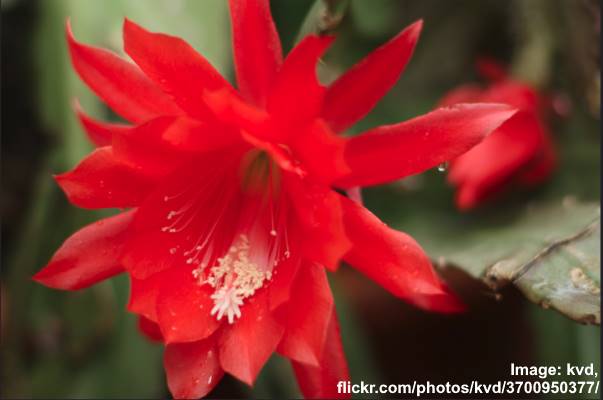
Epiphyllum ‘Miss America’
Epiphyllum ‘Wendy’—The attractive pink orchid cactus has large cup-shaped flowers and long yellowish stamens in the center to add to its beauty.
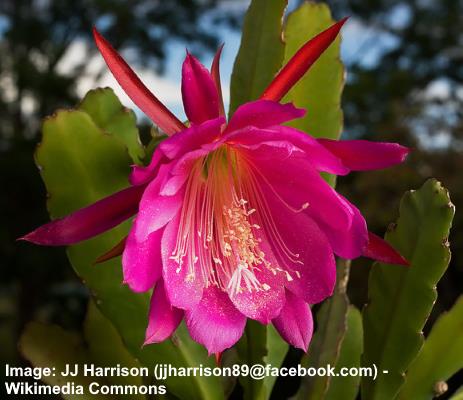
Epiphyllum ‘Wendy’
Epiphyllum ‘King Midas’—Large light orange petals and long stamen make up the magnificent orchid cactus flower.
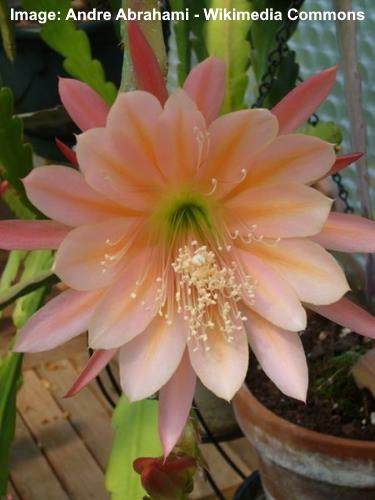
Epiphyllum ‘King Midas’
How to Care for Orchid Cactus (Epiphyllum Cactus)
Proper care ensures that an orchid cactus thrives, blooms every year, and doesn’t succumb to pests and diseases. Here are handy care tips on growing an orchid cactus.
Epiphyllum Cactus Light Requirements
Orchid cactus plants thrive in bright, indirect sunlight. The best location to grow an orchid cactus is in a south-facing location but protected from the hot afternoon sun. The right amount of sunlight throughout the year is vital for the orchid cactus to flower.
An orchid cactus growing in insufficient sunlight usually results in leggy growth and no flowers. However, too much sunlight exposure can cause the leafy stems to yellow and become weak. A healthy orchid cactus should have light to dark-green stems.
Getting the light right is a vital requirement to encourage orchid cacti to bloom. From late winter until fall, the Epiphyllum cactus performs best in filtered bright light. However, in winter, the plant benefits from cooler temperatures and shortened periods of light for eight to ten weeks. During this time, keep watering and fertilization to a minimum.
The Best Soil to Grow Orchid Cactus
A healthy orchid cactus needs to grow in light, moist soil that has excellent drainage. The best potting soil for an Epiphyllum cactus is one part peat moss, one part perlite, and one part orchid bark. A commercial potting mix for cactus plants is also suitable.
Unlike other types of cactus plants, Epiphyllum cacti are not tolerant of drought. Therefore, the potting soil should be constantly moist without ever becoming too soggy. In addition, a peat-based, aerated growing medium will ensure that the plant doesn’t suffer from root decay.
If you live in tropical climates, orchid cactus grows outdoors throughout the year in hanging baskets or rock gardens. If planted in the ground, ensure that the soil is sandy and drains well. During dry, hot summer days, you need to provide extra water to prevent the soil from drying out.
How to Water Orchid Cactus
Watering an orchid cactus just enough to keep the soil moist is essential for the plant’s healthy growth. You know it’s time to water an orchid cactus when the top 1” (2.5 cm) layer of soil is dry. To water the cactus, thoroughly drench the soil until water drains from the pot.
In summer, an orchid cactus could need watering as often as once a week if it’s warm weather. However, in winter, you should only water the cactus houseplant sparingly as it needs to rest. Giving an orchid cactus minimal water in winter is also one of the care tips to encourage blooming in late spring.
Healthy orchid cactus growth requires a delicate balance of getting soil moisture levels right. If you water the cactus too often, the woody stems will become limp and start turning black. On the other hand, giving the plant too little water will hinder flowering, and you’ll miss those spectacular blooms.
Top tip to care for an orchid cactus: Always use filtered tap water at room temperature to water an Epiphyllum cactus. This prevents a mineral buildup in the soil, which could hinder growth.
Orchid Cactus Temperature Requirements
The best temperature range for an Epiphyllum cactus is between 65°F and 75°F (18°C – 24°C). However, getting the temperature right during winter is a challenge. To bloom, orchid cacti require eight to ten weeks in cool temperatures of 60°F to 65°F (15°C – 18°C) during the day and 50°F to 55°F (10°C – 13°C) at night.
Being a type of tropical forest plant, orchid cacti don’t tolerate cold temperatures. A drop in temperature below 50°F (10°C) will affect the orchid cactus plant’s growth. If the temperature drops below 35°F (1°C), the flowering succulent cactus will die.
Epiphyllum Cactus Humidity Needs
In its native environment, an orchid cactus thrives in humid conditions. This versatile houseplant adapts well to average household humidity and performs best when there is 40 to 50 percent relative humidity. If you want to increase humidity, you can place the moisture-loving cactus on a water and pebble tray.
Orchid cacti that grow in the ground in tropical climates rarely have any issues with humidity. However, if the air is particularly arid, you will need to increase the watering frequency.
Fertilizing Orchid Cactus Plants
A potted Epiphyllum cactus benefits from regular fertilization. In fact, adding extra nutrients to the soil is an excellent way to ensure the showy flowers appear in late spring until summer. The key to fertilizing an orchid cactus is to use a balanced fertilizer in spring and fall and a low-nitrogen one at the end of winter.
To fertilize a cactus, use a cactus fertilizer with an NPK ratio of 10-10-10 before and after the cactus flowers. However, as the plant comes out of winter dormancy, use a fertilizer with an NPK ratio of 2-10-10. This is the best way to encourage plenty of flowers to bloom.
Pruning Orchid Cactus
Pruning an orchid cactus is usually necessary to control the length of its stems. Many Epiphyllum species have arching and woody stems that grow 4 to 6 ft. (1.2 – 1.8 m) long. You may have to prune orchid cactus stems if they are dying or turning yellow.
Propagating Orchid Cactus from Leaf Cuttings
It is easy to propagate Epiphyllum cacti using stem cuttings. Although you can use any stems for cuttings, the best ones are those with tiny hairs along the margins. Then, all you need to do is remove a healthy section of stem to propagate.
To propagate an orchid cactus, use sterilized tools to cut a 4” to 6” (10 – 15 cm) piece of stem. Place the cutting on a paper towel for seven days to allow the cut end to form a callus. After that, all you need to do is place the cut end into moist potting soil and keep it in a warm place for three to six weeks. After this time, roots should have formed.
You can then repot your orchid cactus into a new pot or leave it to grow in its existing container.
When Should You Repot Orchid Cactus?
It’s a good idea to repot an orchid cactus every three years or so. Orchid cacti produce more flowers when they are rootbound. Therefore, you don’t need to repot them too often. The best time to repot an orchid cactus is in fall or winter. This way, you won’t stress the roots and affect blooming.
Orchid cactus plants are fast-growing, nutrient-hungry plants that can deplete potting soil of nutrients. Therefore, repotting an Epiphyllum every few years gives you a chance to refresh the soil and replenish nutrients.
When repotting an orchid cactus, choose a pot that is one size larger than its current container. Also, choose an appropriate potting mix for cactus plants.
An alternative to repotting an orchid cactus is to top-dress the plant. This process involves adding a fresh layer of fresh potting mix. All you have to do is remove 2” (5 cm) of potting soil from the top layer. Then add fresh peat moss or compost to the pot and fill the soil to the same level as before.
How to Make Orchid Cactus Bloom
Looking after an orchid cactus is straightforward. However, ensuring that the Epiphyllum cactus blooms regularly is more challenging. Here are four ways to increase the chance of your orchid cactus blooming:
Resting period in winter—Place the orchid cactus succulent in a cool, dry place for eight to ten weeks in winter and water infrequently. This process allows the plant’s buds to set.
Sufficient light—Throughout the year, keep the Epiphyllum cactus in plenty of bright, indirect light. Try to avoid the plant growing in hot, direct sunlight.
Fertilization—In late winter, use a low-nitrogen fertilizer to encourage blooming. When the orchid cactus starts to bloom, stop fertilizing.
Give it some peace—Avoid the temptation to move the plant around too much when buds appear. Sudden changes in light and temperature can cause the buds to drop.
Pests Affecting Orchid Cactus Growth
Orchid cacti can be affected by mealybugs, spider mites, and scale insects. To get rid of bugs from your succulent orchid cactus, use a neem oil spray. Mix 2 tsp. neem oil and 1 tsp. liquid dish soap with a quart (1 l) of water in a spray bottle. Spray all the leafy stems with the DIY neem spray once a week to kill bugs.
Here are some ways to spot the signs of pests on your orchid cactus:
Mealybugs—Small insects that look like spots of cotton and leave behind a cottonwool-like white substance on the orchid cactus fleshy stems.
Spider mites—Look for thin webs or web structures dangling from leaves. Neem oil can kill spider mites fast.
Scale insects—Scale on an orchid cactus is challenging to spot, but look for unusual bump-like growths on the fleshy stems.
Diseases Affecting Orchid Cactus Growth
Root rot and fungal infections are the primary diseases affecting orchid cactus plants. The best way to avoid decaying roots is never to overwater your succulent orchid cactus. Only water the plant when the top layer of soil is dry. On the other hand, never let the soil dry out completely.
Orchid Cactus (Epiphyllum Cactus) Care — FAQs
Is orchid cactus poisonous?
Plants in the genus Epiphyllum are not classified as toxic to humans or animals.
Why are my orchid cactus flower buds dropping?
The most common reason for flower buds to drop from orchid cactus stems is sudden changes in the environment. Factors such as drafts, too much heat, and a lack of humidity are just some of the reasons why flower buds fall off from an orchid cactus stem.
How long does it take for an orchid cactus to bloom?
It takes between three and five years before an orchid cactus blooms. Ways to encourage blooming include allowing the plant to become rootbound, giving it plenty of light, and allowing it to rest in a cool place during winter.
Why isn’t my orchid cactus blooming?
Reasons why an orchid cactus fails to produce flowers include a lack of sunlight, overwatering, few soil nutrients, or high temperatures during winter. In addition, an orchid cactus won’t bloom if the soil doesn’t have enough potassium and phosphorus and too much nitrogen.
How do I know when my night-blooming orchid cactus will flower?
The only way to know if a queen of the night orchid will bloom is to check the flower buds every evening. Typically, nocturnal Epiphyllum cacti bloom once a year during June and July. To capture the spectacular blooming spectacle, check the orchid cactus every evening in the summer to see if the bloom is ready.
Related articles:
